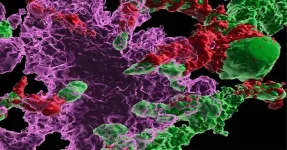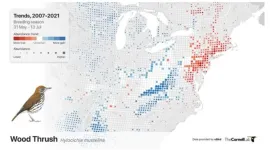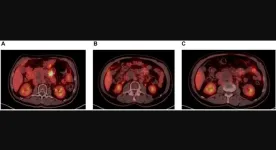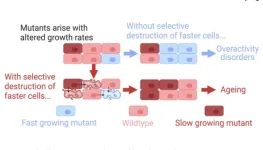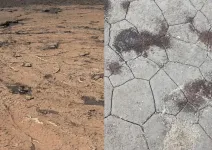(Press-News.org) In the ongoing search for a cure for Alzheimer’s disease, a burgeoning branch of medicine is bringing new hope. Stem cell therapies are already being used to treat various cancers and disorders of the blood and immune system. In a new proof-of-concept study, scientists at University of California San Diego show stem cell transplants may also be a promising therapeutic against Alzheimer’s.
In the study, publishing this month in Cell Reports, the researchers demonstrate that transplanting hematopoietic stem and progenitor cells was effective in rescuing multiple signs and symptoms of Alzheimer’s in a mouse model of the disease. Mice that received healthy hematopoietic stem cells showed preserved memory and cognition, reduced neuroinflammation and significantly less β-amyloid build-up compared to other Alzheimer’s mice.
“Alzheimer’s is a very complex disease, so any potential treatment has to be able to target multiple biological pathways,” said senior study author Stephanie Cherqui, PhD, professor at UC San Diego School of Medicine. “Our work shows that hematopoietic stem and progenitor cell transplantation has the potential to prevent complications from Alzheimer’s and could be a promising therapeutic avenue for this disease.”
The success of the therapy stems from its effects on microglia, a type of immune cell in the brain. Microglia have been implicated in the initiation and progression of Alzheimer’s disease in various ways. It’s known that sustained microglia inflammation can contribute to Alzheimer’s, as the release of inflammatory cytokines, chemokines and complement proteins leads to increased β-amyloid production. In healthy conditions, microglia also play a major role in clearing β-amyloid plaques, but this function is impaired in Alzheimer’s. The resulting β-amyloid build-up also puts stress on other brain cells, including endothelial cells that affect blood flow to the brain.
Postdoctoral researcher and first author Priyanka Mishra, PhD, set out to test whether transplanting stem cells could lead to the generation of new, healthy microglia that might reduce the progression of Alzheimer’s disease. The Cherqui lab had already found success using similar stem cell transplants to treat mouse models of cystinosis, a lysosomal storage disease, and Friedreich’s ataxia, a neurodegenerative disease.
Mishra and her colleagues performed systemic transplantations of healthy wild-type hematopoietic stem and progenitor cells into Alzheimer’s mice and found that the transplanted cells did differentiate into microglia-like cells in the brain.
The researchers then evaluated the animals’ behavior and found that memory loss and neurocognitive impairment were completely prevented in mice that received the stem cell transplant. These mice showed better object recognition and risk perception, as well as normal anxiety levels and locomotor activity, compared to non-treated Alzheimer’s mice.
Looking closer at the animals’ brains, the researchers found that mice treated with healthy stem cells showed a significant reduction in β-amyloid plaques in their hippocampus and cortex. The transplant also led to reduced microgliosis and neuroinflammation, and helped preserve the integrity of the blood-brain barrier.
Finally, the researchers used transcriptomic analyses to measure the expression of different genes in treated and non-treated Alzheimer’s mice. Those that had received the stem cell therapy had less cortical expression of genes associated with diseased microglia, and less hippocampal expression of genes associated with diseased endothelial cells.
Altogether, the transplantation of healthy hematopoietic stem and progenitor cells led to enhanced microglia health, which in turn protected against multiple levels of Alzheimer’s pathology.
Importantly, a third group of mice that received stem cells isolated from Alzheimer’s mice exhibited no signs of improvement, demonstrating that these cells retained the disease-related information in Alzheimer’s disease.
Future studies will further explore how the healthy transplanted cells produced such significant improvements, and whether similar transplant strategies can be used to alleviate Alzheimer’s symptoms in humans.
“Alzheimer’s disease poses a major emotional and economic burden on our society, yet there is no effective treatment available,” said Cherqui. “We are excited to see such promising preclinical results from hematopoietic stem cell therapy and look forward to developing a new therapeutic approach for this devastating disease.”
Co-authors of the study include: Alexander Silva, Jay Sharma, Jacqueline Nguyen, Donald P. Pizzo and Debashis Sahoo, all at UC San Diego, as well as Denise Hinz at the La Jolla Institute for Immunology.
# # #
END
Stem cell therapy rescues symptoms of Alzheimer’s disease
UC San Diego study shows hematopoietic stem cell transplants can protect against memory loss, neuroinflammation and β-amyloid build-up in Alzheimer’s mice
2023-08-09
ELSE PRESS RELEASES FROM THIS DATE:
Penn Medicine neuroscientists identify brain mechanism that drives focus despite distractions
2023-08-09
PHILADELPHIA—Trying to finish your homework while the big game is on TV? “Visual-movement” neurons in the front of your brain can help you stay focused, according to a new study from neuroscientists in the Perelman School of Medicine at the University of Pennsylvania.
In the study, published recently in Neuron, the scientists sought to illuminate the neural mechanism that helps the brain decide whether to focus visual attention on a rewarding task or an alluring distraction. By analyzing neuron activity in animal models as they faced this kind of attentional ...
Novel machine-learning method produces detailed population trend maps for 550 bird species
2023-08-09
Scientists at the Cornell Lab of Ornithology have developed a novel way to model whether the populations of more than 500 bird species are increasing or decreasing. The method solves a nagging statistical problem by accounting for year-to-year changes in the behavior of people collecting the data. The result is detailed trend maps for each species down to an eight-mile radius--a major boost for local conservation efforts. Scientists used an approach called Double Machine Learning. Details are published in the journal Methods in Ecology and Evolution.
“Changing human behavior presents a problem for statistical analysis ...
CDK9 Inhibitors: A promising combination partner in treating hematological malignancies
2023-08-09
“[...] CDK9 inhibitors could play a role in future treatments of hematological diseases and could be a great ally when combined with other therapeutic approaches.”
BUFFALO, NY- August 9, 2023 – A new research perspective was published in Oncotarget's Volume 14 on August 7, 2023, entitled, “CDK9 INHIBITORS: a promising combination partner in the treatment of hematological malignancies.”
In their new perspective, researchers Daniel Morillo, Gala Vega and Victor Moreno from Hospital Fundación Jiménez Díaz discuss Cyclin-dependent ...
A novel theory of aging — independent of damage accumulation
2023-08-09
“We argue that in multicellular organisms, neighbouring cells are in constant competition.”
BUFFALO, NY- August 9, 2023 – A new editorial paper was published in Aging (listed by MEDLINE/PubMed as "Aging (Albany NY)" and "Aging-US" by Web of Science) Volume 15, Issue 14, entitled, “A novel theory of ageing independent of damage accumulation.”
The underlying cause or causes of aging are an enduring mystery, but in 1977 Kirkwood postulated that organisms might gain a fitness advantage by reducing investment in somatic maintenance if this allowed them to invest more resources in more crucial ...
Long-term use of certain acid reflux drugs linked to higher risk of dementia
2023-08-09
MINNEAPOLIS – People who take acid reflux medications called proton pump inhibitors for four-and-a-half years or more may have a higher risk of dementia compared to people who do not take these medications, according to new research published in the August 9, 2023, online issue of Neurology®, the medical journal of the American Academy of Neurology. This study does not prove that acid reflux drugs cause dementia; it only shows an association.
Acid reflux is when stomach acid flows into the esophagus, usually after a meal or when lying down. People with acid reflux may experience heartburn and ulcers. People ...
Research sheds new light on gene therapy for blood disorders
2023-08-09
Research from experts at Michigan Medicine, the Children’s Hospital of Philadelphia and Penn Medicine is breaking ground on new ways of treating blood disorders, such as sickle cell anemia, through gene therapy.
To cure blood disorders, patients must undergo high dose chemotherapy and bone marrow transplantation. This requires a match between the recipient and donor immune system, but ~30% of patients do not have a match. Even when they do the donor immune system can attack the patient, graft versus host disease.
Gene therapy corrects the mutation in a patient’s own cells ...
Few in US recognize inequities of climate change
2023-08-09
ITHACA, N.Y. – Despite broad scientific consensus that climate change has more serious consequences for some groups – particularly those already socially or economically disadvantaged – a large swath of people in the U.S. doesn’t see it that way.
A new national survey study found that just over one-third of U.S. adults believe climate change is impacting some groups more than others. Nearly half feel that climate change impacts all groups about equally. And when the question referenced race in climate impacts, even fewer people believed some groups are more adversely affected than others.
“Our earlier research showed that ...
New research points to possible seasonal climate patterns on early Mars
2023-08-09
New observations of mud cracks made by the Curiosity Rover show that high-frequency, wet-dry cycling occurred in early Martian surface environments, indicating that the red planet may have once seen seasonal weather patterns or even flash floods. The research was published today in Nature. “These exciting observations of mature mud cracks are allowing us to fill in some of the missing history of water on Mars. How did Mars go from a warm, wet planet to the cold, dry place we know today? These mud cracks show us that transitional time, when liquid water was less abundant but still active on the ...
US municipal bond market pricing may be biased by race, unphased by climate risk
2023-08-09
New research suggests that the US municipal bond market systemically misprices risk, as the pricing of municipal debt does not account for local physical climate risk, but does demand larger credit spreads from communities with a larger proportion of Black residents. Erika Smull of Duke University, US, and colleagues present these findings in the open-access journal PLOS ONE on August 9.
Across the US, local governments issue municipal bonds to help fund various expenses, such as schools and sewer systems. ...
Two-thirds of turtle injuries and strandings recorded in the Maldives across 12 years arose from entanglement with lost and discarded fishing gear
2023-08-09
Two-thirds of turtle injuries and strandings recorded in the Maldives across 12 years arose from entanglement with lost and discarded fishing gear
###
Article URL: https://journals.plos.org/plosone/article?id=10.1371/journal.pone.0289167
Article Title: Evaluation of sea turtle morbidity and mortality within the Indian Ocean from 12 years of data shows high prevalence of ghost net entanglement
Author Countries: Republic of the Maldives
Funding: The authors received no specific funding for this work. END ...
LAST 30 PRESS RELEASES:
Interaction of climate change and human activity and its impact on plant diversity in Qinghai-Tibet plateau
From addressing uncertainty to national strategy: an interpretation of Professor Lim Siong Guan’s views
Clinical trials on AI language model use in digestive healthcare
Scientists improve robotic visual–inertial trajectory localization accuracy using cross-modal interaction and selection techniques
Correlation between cancer cachexia and immune-related adverse events in HCC
Human adipose tissue: a new source for functional organoids
Metro lines double as freight highways during off-peak hours, Beijing study shows
Biomedical functions and applications of nanomaterials in tumor diagnosis and treatment: perspectives from ophthalmic oncology
3D imaging unveils how passivation improves perovskite solar cell performance
Enriching framework Al sites in 8-membered rings of Cu-SSZ-39 zeolite to enhance low-temperature ammonia selective catalytic reduction performance
AI-powered RNA drug development: a new frontier in therapeutics
Decoupling the HOR enhancement on PtRu: Dynamically matching interfacial water to reaction coordinates
Sulfur isn’t poisonous when it synergistically acts with phosphine in olefins hydroformylation
URI researchers uncover molecular mechanisms behind speciation in corals
Chitin based carbon aerogel offers a cleaner way to store thermal energy
Tracing hidden sources of nitrate pollution in rapidly changing rural urban landscapes
Viruses on plastic pollution may quietly accelerate the spread of antibiotic resistance
Three UH Rainbow Babies & Children’s faculty elected to prestigious American Pediatric Society
Tunnel resilience models unveiled to aid post-earthquake recovery
Satellite communication systems: the future of 5G/6G connectivity
Space computing power networks: a new frontier for satellite technologies
Experiments advance potential of protein that makes hydrogen sulfide as a therapeutic target for Alzheimer’s disease
Examining private equity’s role in fertility care
Current Molecular Pharmacology achieves a landmark: real-time CiteScore advances to 7.2
Skeletal muscle epigenetic clocks developed using postmortem tissue from an Asian population
Estimating unemployment rates with social media data
Climate policies can backfire by eroding “green” values, study finds
Too much screen time too soon? A*STAR study links infant screen exposure to brain changes and teen anxiety
Global psychiatry mourns Professor Dan Stein, visionary who transformed mental health science across Africa and beyond
KIST develops eco-friendly palladium recovery technology to safeguard resource security
[Press-News.org] Stem cell therapy rescues symptoms of Alzheimer’s diseaseUC San Diego study shows hematopoietic stem cell transplants can protect against memory loss, neuroinflammation and β-amyloid build-up in Alzheimer’s mice
